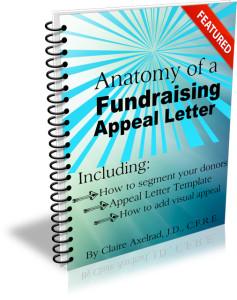
Get friendly pointers to annual appeal success!
The end of the calendar year is prime fundraising season. For most nonprofits, September through December will make or break your annual campaign. So… I want you to do the following:
- If you’re just sitting down to write your appeal letter, use this as your step-by-step guide to crafting a winning fundraising offer.
- If you’ve already written your appeal letter, use this as your step-by-step checklist to assure your fundraising offer is truly one a prospective donor won’t be able to refuse.
- Vow next year to have at least your appeal letter draft written and approved by September 1st. Put this date in your calendar, and work backward to create a timeline of all the steps necessary to meet this deadline. This will give you plenty of time to tweak your appeal language for different mailing segments, prepare your email and social media campaign using messaging and images from your mail appeal, get the letter to the printer and mail house, and prepare your carrier envelope, remit piece, donation landing page, thank you letter and overall acknowledgment plan.
10 Step Annual Appeal Preparation Plan
1. Pick a STORY to lead with.
People give when their hearts are touched. Usually from ONE compelling story. Don’t fall into the trap of beginning your story with a history of your organization’s mission, or a bunch of statistics. Your appeal is not supposed to be educational; make it emotional! The best way to do this is through storytelling. You can’t explain folks into giving.
2. Find a compelling PHOTO to visually tell your story.
People look at photos before text. Make yours worth the proverbial 1000 words. Best photos are headshots. People like to look at people. Or animals. Not vacant buildings. Add a little zing with the addition of a compelling caption. Voila! You should have almost your entire appeal message: here’s the problem/here’s the solution needing your help.
3. Decide WHO will tell your story.
It can be narrated by a well-known leader such as your E.D. or Board President. It can be told by a relevant local, national or international celebrity. It can be told by a beneficiary of your services (even if that beneficiary is an animal, tree or painting). The point is that who the letter comes from matters. Folks will look first at the salutation (make sure it’s personal!); then at the signature.
4. Write a zingy, one-sentence OPENING line.
After photo, salutation, signature and postscript, the opening line is what people will most likely read. Come up with something memorable and “sticky” with which folks can easily connect. Don’t begin with “On behalf of the board and staff, I’m writing today to…” Yawn. You have about two seconds to grab people’s attention; make it count! Jump into the story right away.
EXAMPLES:
- Lake Louise used to provide water for the whole county; in 20 years, people won’t be able to swim in it, let alone drink it. (Unless you help).
- At 12 Alicia was sold into sexual slavery and will likely be dead in 7 years. (Unless you help.)
- Sylvia may never see her 3-year-old son again. (Unless you help.)
5. Write a P.S.
I never write an appeal without a P.S. In fact, sometimes I write the P.S. first. Another tip is to write your letter; then take a good look at it and pull out your most important message and move it to the P.S. to assure it’s seen. It may be all folks read (see Asking Properly: the art of creative fundraising by George Smith). Don’t use the P.S. as a throw-away to add extraneous stuff that’s not really related to your appeal (e.g., “We have an upcoming event;” “We have inserted a brochure with volunteer opportunities.”). This is the Boardwalk and Park Place of your letter – extremely valuable real estate.
6. Include an up-front, ASK.
Don’t pussyfoot around. Ask in the first few paragraphs; then again at end. Avoid the “dead zone” (upper to middle paragraphs of the last page). Eye motion studies show ‘hot spots; where the eye goes first and last. You want to put your most potent words in these hot spots (e.g., at the beginning or end of a page, sentence or paragraph), not buried somewhere in the middle. And because people skim, and you’re never really sure which part of the letter their eyes will land on, ask early and often.
7. Make the ask SPECIFIC.
The most compelling appeals ask for a specific amount for a specific purpose. Tell your donor what the solution to the problem costs, and let them know how they can make a meaningful contribution. Don’t simply say “Please support us” or “A gift of any amount will help.” The donor shouldn’t have to guess at what you need.
8. Make sure you address the donor’s WIIFM question.
In deciding whether to give/not give, donors will unconsciously ask “What’s In It For Me?” Make sure you address donor benefits. Include donor rewards in your appeal.
EXAMPLES:
- Tax benefits
- Feeling good about self
- Fulfilling religious or moral obligation
- Giving back
- Doing unto others as
- Assuring help will be there should you ever need it
- Receiving something you value (e.g. a tote bag; preferred seating; membership in an elite society)
- Improving your community (more liveable, prestigious, beautiful, fun)
9. Include some URGENCY.
Why must the donor give now? Is this a crisis demanding immediate response? Do you have a challenge grant? A deadline that’s approaching? Don’t sigh and say you don’t have an urgent reason. Get creative and find a reason for folks to respond to the problem you posed with your photo and opening line. Don’t let the donor put down your appeal without responding.
10. Get rid of all the EGO-CENTRIC stuff.
Cross out every “I,” “we,” and “our organization” and replace with “you” and “your.” It’s imperative your put your donor front and center in your fundraising offer. “You did this.” “You are caring.” “Your support makes it happen.” Make your donor the hero.
SUMMARY
When crafting your appeal, keep in mind the following keys to success:
- What do you want donors to think?
- What do you want donors to feel?
- What do you want donors to do?
Review your appeal and see if it does what you set out to accomplish. Ask someone objective to review your appeal and see what they think, feel and want to do. Your donor should (1) think you’ve outlined a relevant problem they care about; (2) feel emotionally inspired to help solve the problem, and (3) compelled to take the specific action you’ve requested.
Of course, there’s more to say. There always is. But this will give you a terrific head start!
Want More Help Creating a Compelling Appeal?

This 62-page guide will take your appeal letter from run of the mill to out of the ballpark!
Grab Anatomy of a Fundraising Appeal Letter + Sample Template. Writing a compelling fundraising letter can be tricky. It’s not the same kind of writing as a brochure, annual report or grant proposal. But it’s not rocket science – it’s something you can easily learn. It’s just not something most of us are taught. Want to learn what you need to know to become a fundraising master? You can do this!
And if you’re not satisfied, for any reason, you have the Clairification 30-day no-questions-asked 100% refund guarantee.






hi Claire,
excellent as usual. can i write the letter and you would give me your comments?
Thanks Nini. Sadly, I can’t review everyone’s letter or I’d be working 24/7 — and then some! If you’d like to grab an Hour of Power or Package of Power, feel free. https://clairification.com/hour-of-power/ I just sent you a separate email with more details.
What are your thoughts on the length of the letter? Lately I’ve been getting some 4-page letters (with lots of white space and short paragraphs), which seems excessive.
Nope. Not excessive at all. A letter should be as long as it needs to be to tell a compelling story that makes the would-be donor want to jump into the narrative and come to the rescue. Generally, when you’re writing to current donors the letter can be shorter because they already know some of the story and don’t need all the background. When writing to acquire brand new donors, the letter may need to be longer. Remember, too, that people skim. You never know which parts their eyes will go to. So you need to make key points multiple times. In the sub-heads. In the boldface. In the underlines. In the bullets. In the italics. In the photo caption. In the P.S. And on the remit piece. I’ve heard of even 12-page letters doing well. KEY POINT: You are not your donors. Some folks like to read longer letters. If you want to know what works best for your organization, your best bet may be to do a split test. Hope this helps!